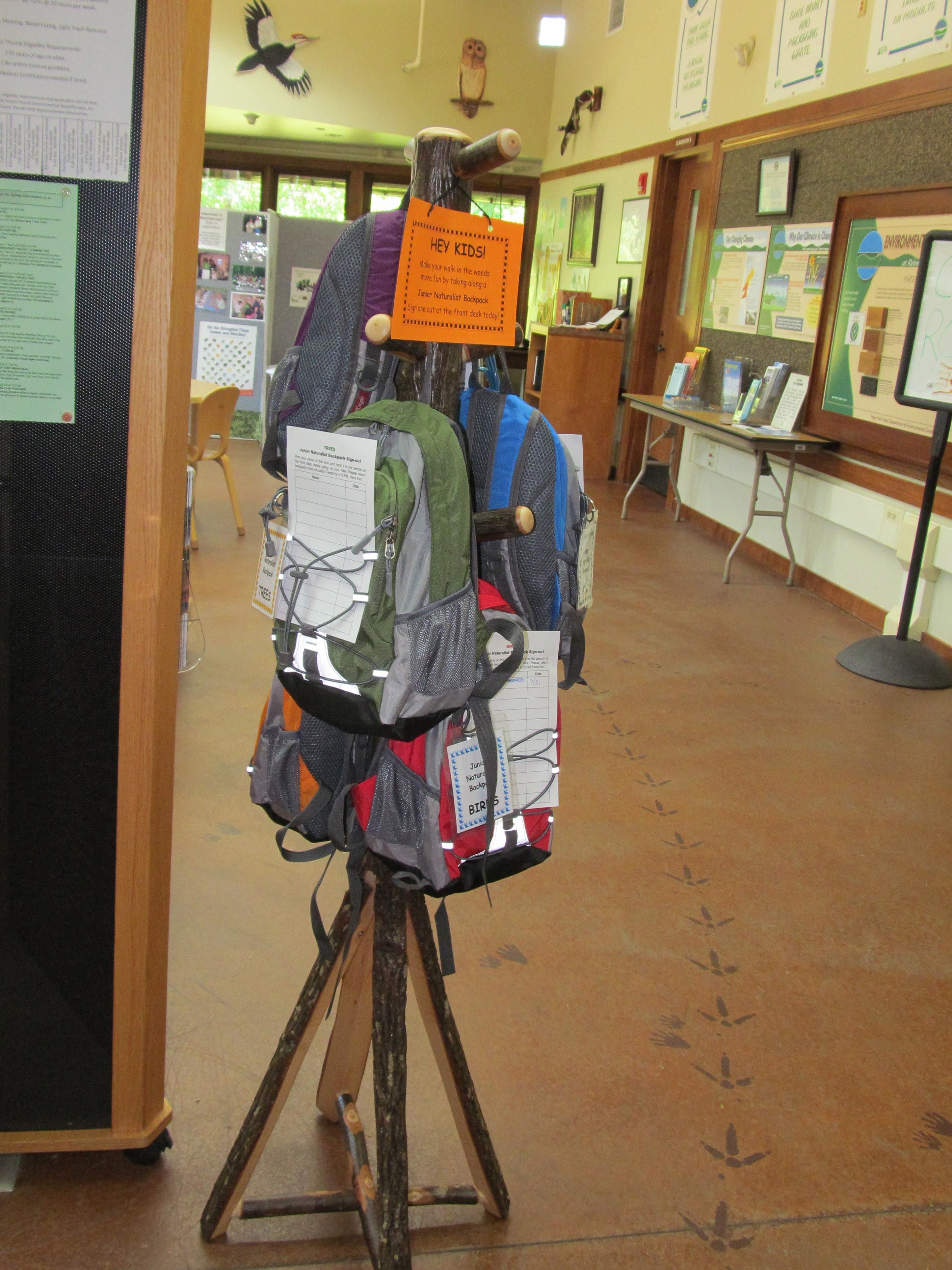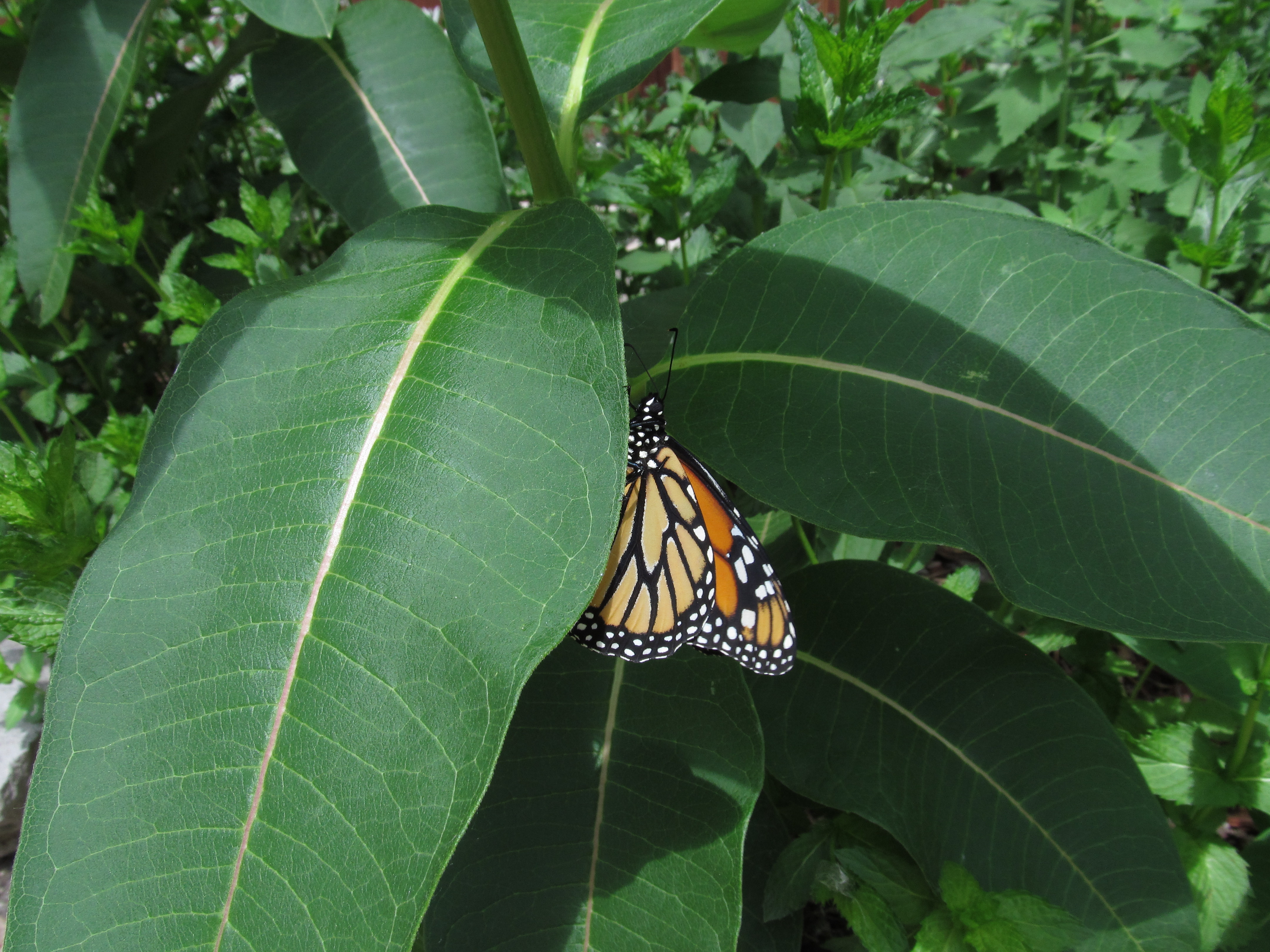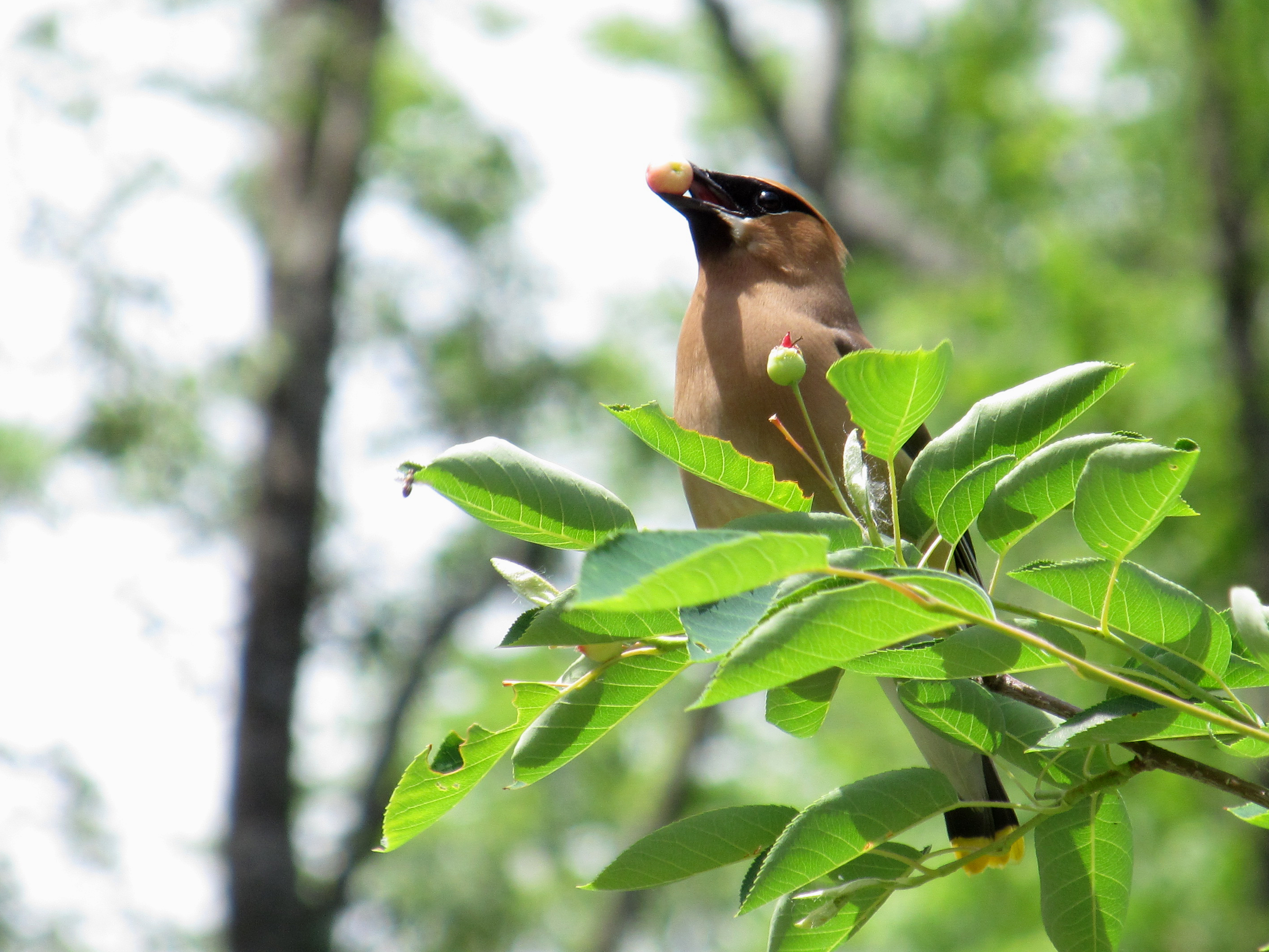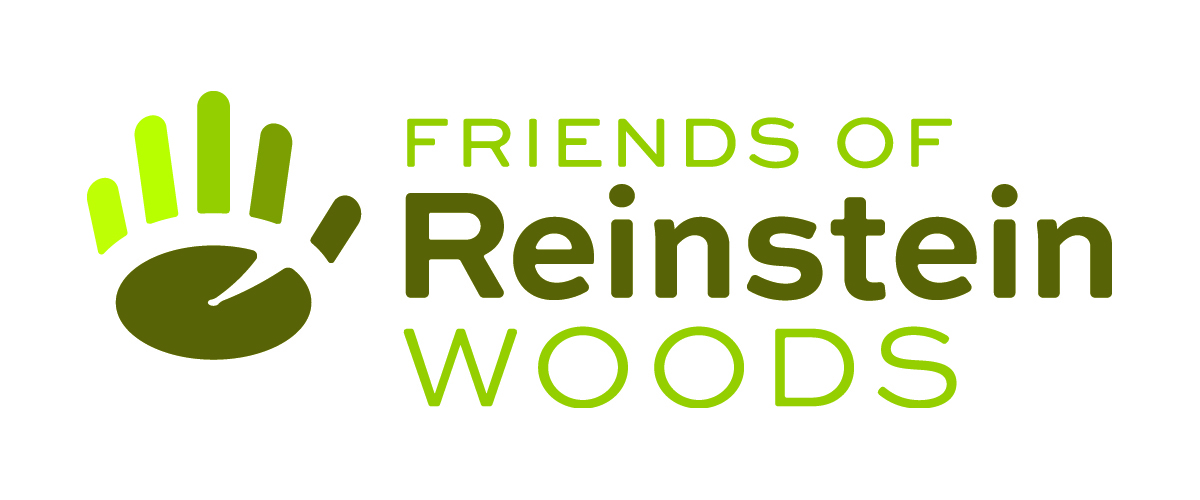All posts by Reinstein Woods
Garden Partnership Blooms!
We’re all familiar with kids not wanting to eat their vegetables, but how many kids have no idea where vegetables even come from? Thanks to a new partnership, kids at the Gloria J. Parks (GJP) Community Center in Buffalo will not only know, but they’ll be growing their own vegetables! DEC’s Ginger Wszalek worked with Friends of Reinstein Woods and the community center to partner with Grassroots Gardens of Buffalo. Grassroots Gardens is providing funds for rooftop gardens at the community center.
During the school year, DEC ran an After School Conservation Club for kids participating in GJP’s after-school program. To build on the nature programming they received, Wszalek, along with volunteer Pat Taeger, helped the second graders plant vegetables, herbs, fruit and flowers in containers while the rooftop was being renovated. They taught the students “companion planting” techniques to help each plant grow stronger and tastier. Summer session attendees also enjoyed gardening, worm composting and garden art programs. Along the way, the children learned the life cycles of the plants and participated in basic garden maintenance.
The children especially enjoyed making recycled plant markers from blind shades to identify the plants in the pots. As of mid-August, the children had been able to to taste edible flowers and experience the joy of eating fresh blueberries and kale. Soon they will be enjoying cherry tomatoes, cucumbers, green peppers, spinach, celery, strawberries and fresh-cut herbs. The center also provides cooking classes to the children, and they are eager to use the vegetables and herbs in their dishes.
Additional garden beds and vertical garden beds will be built on the rooftop soon for next year.
GMC, Other Awards Given at Volunteer Picnic
Tree Talk (A message from the President)
I’m trying to write this article as my wife and I volunteer at the Erie County Fair for Reinstein Woods. I’m not getting a lot done because so many people stop by our display and inquire about the “Woods.” I think most of the interest involves the ornate display created by Reinstein Woods Educator Ginger Wszalek which includes spinning CD “tops,” a water bottle recycle bin and the flowering water hoses. There was a lot of interest shown by many of the fair goers.
My main purpose for this article is to ask for your help. A recent “MY View” article in the Buffalo News caused me to think about inviting Friends members to contribute a column to this newsletter. It could serve as a way to solicit thoughts and ideas from those who are members and want to be more engaged. Nature-related themes would be the main focus of the column. We will title the column “Tree Talk,” and if successful have an article appear in each edition of this newsletter. If many articles are submitted we could establish a screaming, I mean a screening, group to review. If you are interested in contributing, or have comments please let us know by emailing president@reinsteinwoods.org or by calling the office at 683 5959.
Thanks for your interest; we look forward to seeing you and your family this fall!!!!
– Michael Gettings, President
Junior Naturalist Backpacks Available to Borrow
Stop into the Reinstein Woods Environmental Education Center and borrow one of our new  “Junior Naturalist Backpacks”. Each backpack has a different theme, including: animal signs, birds, bugs, pond life, and trees. Inside the backpack are tools to help you discover nature on the trail. The pond life bag contains small nets and containers to magnify your catch. Aslo included are field guides to help you identify the animals you find. There are scavenger hunts and other activities associated with each theme as well. The education center is open Monday to Friday from 9am – 4:30pm and Saturday from 1pm – 4:30pm. We request that the backpacks are returned by 4:15pm the day they are borrowed.
“Junior Naturalist Backpacks”. Each backpack has a different theme, including: animal signs, birds, bugs, pond life, and trees. Inside the backpack are tools to help you discover nature on the trail. The pond life bag contains small nets and containers to magnify your catch. Aslo included are field guides to help you identify the animals you find. There are scavenger hunts and other activities associated with each theme as well. The education center is open Monday to Friday from 9am – 4:30pm and Saturday from 1pm – 4:30pm. We request that the backpacks are returned by 4:15pm the day they are borrowed.
Nature Sightings
We are just beyond peak dragonfly season at Reinstein Woods. However you may still see as many as 12 different species of dragonflies and damselflies at the preserve. Flattail Lake  is a hotspot for their activity. Some species to look for are eastern amberwings, Halloween pennants, blue dashers, Eastern forktails, and widow skimmers. There are a pair of fawns that visitors have seen very frequently along the trails. There are also several bucks in the preserve with velvet antlers, most with just 4 or 6 points on their rack. Come check out our new honey bee hive in the nature viewing area of our education center. If you enjoy butterflies you may look for silver spotted skippers, red admirals, and great spangled fritillaries visiting flowers around the education center. A few weeks ago you may have noticed monarch butterflies in flight at
is a hotspot for their activity. Some species to look for are eastern amberwings, Halloween pennants, blue dashers, Eastern forktails, and widow skimmers. There are a pair of fawns that visitors have seen very frequently along the trails. There are also several bucks in the preserve with velvet antlers, most with just 4 or 6 points on their rack. Come check out our new honey bee hive in the nature viewing area of our education center. If you enjoy butterflies you may look for silver spotted skippers, red admirals, and great spangled fritillaries visiting flowers around the education center. A few weeks ago you may have noticed monarch butterflies in flight at  Reinstein Woods. Now is a good time to look at common milkweed leaves for monarch caterpillars. You may also find Milkweed beetles nibbling on milkweed leaves. On your next visit, listen for the buzz of cicadas high in the trees. Later in the evening you may also hear grey tree frogs in chorus. You may also see small leopard frogs zig-zagging in the grass as you walk along the ponds. They recently emerged in great numbers from the ponds. Keep your eyes open for hummingbird moths, they will be nectaring flowers shortly.
Reinstein Woods. Now is a good time to look at common milkweed leaves for monarch caterpillars. You may also find Milkweed beetles nibbling on milkweed leaves. On your next visit, listen for the buzz of cicadas high in the trees. Later in the evening you may also hear grey tree frogs in chorus. You may also see small leopard frogs zig-zagging in the grass as you walk along the ponds. They recently emerged in great numbers from the ponds. Keep your eyes open for hummingbird moths, they will be nectaring flowers shortly.
Nature Sightings at Reinstein Woods
Common milkweed is blooming, providing a source of nectar for returning monarch butterflies. Check for eggs or young caterpillars on the underside of milkweed leaves. Many  insects will defoliate leaves from the underside to remain out of sight from hungry birds. Fruits and nuts are beginning to grow on trees. Black walnuts are currently about the size of peach pits. The outer green flesh of the walnuts have a bitter citrus odor to them. Wild grapes are about the size of a bb and remain green in color. Serviceberry or shadbush trees in front of the education center have fruits that are ripe. Cedar waxwings, gray catbirds and American robins are devouring these berries. Dragonflies and
insects will defoliate leaves from the underside to remain out of sight from hungry birds. Fruits and nuts are beginning to grow on trees. Black walnuts are currently about the size of peach pits. The outer green flesh of the walnuts have a bitter citrus odor to them. Wild grapes are about the size of a bb and remain green in color. Serviceberry or shadbush trees in front of the education center have fruits that are ripe. Cedar waxwings, gray catbirds and American robins are devouring these berries. Dragonflies and  Damselflies are very abundant right now. You may see as many as a dozen species as you walk through the preserve. Some of the more striking species include ebony jewelwings, eastern pondhawks, and 12-spotted skimmers. Tiny American toadlets are leaving ponds and hopping about in search of small insects to eat. Painted turtles are seen crossing trails as they search for loose soil to lay their eggs. Spittle bugs are also common along the trails. They are found on plant stalks and create a retreat out of bubbly plant juices they excrete. It won’t be long and the white-tailed deer bucks will begin growing their velvet antlers.
Damselflies are very abundant right now. You may see as many as a dozen species as you walk through the preserve. Some of the more striking species include ebony jewelwings, eastern pondhawks, and 12-spotted skimmers. Tiny American toadlets are leaving ponds and hopping about in search of small insects to eat. Painted turtles are seen crossing trails as they search for loose soil to lay their eggs. Spittle bugs are also common along the trails. They are found on plant stalks and create a retreat out of bubbly plant juices they excrete. It won’t be long and the white-tailed deer bucks will begin growing their velvet antlers.
Introducing the Mustard Maulers
Reinstein Woods is all about nature, the changing seasons and team work. Teamwork is an important part of a favorite American spring pass time: baseball. Reinstein Woods and baseball may not seem to tie together, but this year there’s a definite parallel: I’d like to introduce our new board of directors’ Garlic Mustard Challenge team “The Mustard Maulers.”
Most sports are based on traditions, and at Reinstein Woods we conduct an annual Garlic Mustard Challenge as an important tradition. Baseball has a season, and a league. Our season runs from April 18 to June 18 and we are part of the Invasive Species league. Baseball games are generally played in stadiums; most of our “games” are held at places like Flattail Lake, Secluded Swamp and Muskrat Marsh.
Nicknames play a big role in baseball and throughout the years I recall names like “The Babe,” “Rocky,” “Catfish” and “The Mick.” Our roster includes, “Vida Blue Vinod,” “L A Banks,” “Terry the Pirate” and “Casey” our leader, to name just a few.
Our team “The Mustard Maulers” held opening day on Sunday, May 17 when we pulled 40 pounds of garlic mustard from Reinstein Woods. Our team color is, naturally, mustard yellow. We have a young [?] talented team, we play to win, but we are not Hot Dogs. The Garlic Mustard plant is a tough opponent!!!
The GMC continues through June 18, so there is still time for you to join the league. More information is available at the League office, 93 Honorine Drive Depew, NY or by calling Matt at (716)683-5959.
- Mike Gettings [aka, Johnny Mustard Seed]
Polar bears, minivans and an elephant: Reinstein Woods helps Buffalo Students recycle!
“Our students have been so excited to see all of the materials that they are helping to recycle. Many teachers and parents have also commented on how great this was.” – Teacher at BPS 33
You may recall from the last newsletter that New York is making a push to keep clothing out of landfills by raising awareness about what to do with old clothing and textiles. To help promote this effort, Friends of Reinstein teamed with the City of Buffalo, DEC and the WNY Coalition for Donated goods to sponsor an “Earth Day Clothing Drive” in Buffalo Public Schools.
Students from eleven Buffalo public and charter schools collected clothing that was removed for recycling or reuse by the WNY Coalition for Donated Goods, a collaboration of nonprofit organizations whose goal is to promote both the community and the environment through the donation of clothing and other goods.
DEC Region 9 Director Abby Snyder and Deputy Mayor Dr. Ellen Grant congratulated students at a ceremony at School 45 (International School). Some of the schools competed to see which class in the school could collect the most clothing. The winning class received a pizza party from Hearts for the Homeless and the City of Buffalo, and the runner-up class received Smencils courtesy of Reinstein Woods. Olmsted School 64 had the highest collection total, saving more than 3,605 pounds of clothes, bedding, and related textile accessories from ending up in a landfill.
Overall, the eleven schools collected 11,244 pounds of clothing. How much is that? It’s equivalent to the weight of:
- 5 polar bears,
- 2.5 minivans, or
- 1 elephant!
Kudos also goes to Grand Island High School and Huth Road Elementary School in Grand Island, who organized an Earth Day clothing drive too and collected an additional 1,704 pounds of clothing that was given to the Coalition for recycling.
What Happens When You Flush?
Warning: This story may gross you out. But it will leave you with a greater appreciation of our water resources, so keep reading!
When you flush a toilet at Reinstein Woods, the waste heads through pipes all the way to the Buffalo Sewage Authority’s Bird Island Treatment Plant, located on an actual island just off shore from Buffalo’s Westside and Black Rock neighborhoods. The plant is the second largest sewage treatment plant in the state, and it accepts waste from the city of Buffalo as well as some surrounding suburbs and some septic and grease collection companies.
Thanks to Friends’ board member Denine Jackson, who works in the laboratory at the plant, the Reinstein Woods staff recently toured the plant to better understand the water systems we discuss with students during our popular “Watershed Works” program. On the day of our visit, the plant was anticipating about 120 million gallons of wastewater to flow through the plant, just on that day. The plant is rated to accept up to 560 million gallons per day.
The tour of the plant was fascinating, and staff encountered sewage industry terms like “mixed liquor,” “sludge cakes” and “scum beach” that refer to things that are pretty much as disgusting as they sound. We toured the tallest building on site called the “Megastructure,” a name that made me think we were entering a superhero movie ride, except the only thing taking a ride inside of it was sewage sludge. Sewage sludge is basically all the “solids” in a wastewater stream. The sludge moves through pipes and on conveyor belts through the Megastructure, removing water along the way until eventually the solids end up in an incinerator.
The incinerator is powered by methane collected from “digesters,” giant round tanks where micro-organisms break down waste, giving off methane in the process. By the time the wastewater stream has gone through the digesters, the Megastructure and all of the other treatment steps, most of the human waste and other solids have been removed from the water itself, and the water is eventually discharged into Lake Erie.
None of this, however, is the part that should gross you out. The plant workers take their jobs very seriously and do a heroic job of dealing with waste that the rest of us would like to forget is a part of daily life. They make the water as safe as they can before discharging it back into Lake Erie.
The gross part, what I found upsetting about the tour, was the amount of non-human waste that is in the waste stream. We women are especially bad culprits: plastic tampon applicators were EVERYWHERE. And I mean everywhere; at certain stages the wastewater is in giant outdoor tanks that are open to the air, and birds would pluck objects that float out of the tanks and drop them around the grounds. You get the picture. Even near the end of treatment, a couple steps before the water is chlorinated and released into Lake Erie, workers still have to fish applicators out of the water stream.
Considering we use Lake Erie and the Niagara River for important things like drinking water, we can all do ourselves a favor by not flushing anything down the toilet that isn’t human waste or toilet paper. And I think the plant workers will thank us too!
– Meaghan Boice-Green, Reinstein Woods Center Director
Spring donors help trees and more!
Friends of Reinstein Woods extends a huge thank you to all the folks who donated generously to the Spring It On campaign (raising funds to protect ash trees at Reinstein Woods) and to the Friends’ Annual Earth Day Appeal (which raises general operating funds). The two efforts have netted thousands of dollars in support for Reinstein Woods!
The annual appeal is continuing, so consider donating generously today.
Spring It On Donors:
Gasper Aronica, Kathleen Boice, Meaghan Boice-Green, Terry Boyle, Cheryl Buechi, Dan Carlson, Gerry Casey, Rachel Chrostowski, Seaghan Coleman, Mary Ann Cortese, Margaret Diamond, Stefanie Ecker, Michael Gettings, Mary Gloss, Charles Kelly, Carolyn Kerr, Steven Kondrak, Tom & Sue Lawson, Mary Losi, Diane McMahon, Kelly Mayer, Gary & Maria Michalski, Barry Martin, Christina Michalczak, Dale & Carol Milsom, Charles Rauch, Kristen & Chuck Rosenburg, Dawn and Chuck Pustelnik, Brittany Rowan, Brigitte Schick, Lori Stilwell, Michelle Woznick, Ginger Wszalek
Annual Appeal Donors:
Amos Acree, Therese Adriaansen, Valerie Antos, Linda Arndt, Irene Benbenek, Ann & Dennis Bischof, David & Kathy Boice, Meaghan Boice-Green, William Breslin, Peter and Cheryl Buechi, Michael Campanella, Helen Cyrulik, Ronald Dekanski, Alfred Dittenhauser, Dave Dziedzic, Stefanie Ecker, Jade Feeney, Mike & Carol Gettings, Don & Alice Gray, Marilyn Gross, Elaine Hansen, Judy Hendee, Anne Izydorczak, Dennis & Rebecca Kaniecki, Luke Kantor, David & Carolyn Karb, David Kennedy, Irene Konowka, Ed Kowalski, Dave & Alice LaGraves, Mary Losi, Lawrence & Amanda Megan, Donna Michael, S. David & Catherine Miller, Barbara Morrisey, Tom & Andrea Mudd Sr., Beth Munson, Dennis & Sandy Needham, Jim & Marcia Nixon, Albert & Sharon Oehler, Peter & Patricia O’Hara, Siri Paolino, Patricia Perry, Dave & Sandy Peruzzini, Bob & Shari Rembold, Paul & Joanne Rickard, Shirley Shannon, Scot & Karen Smith, Dorothy Socie, Gary Steils, Lori Stilwell, Tom Stoll, Sandra Szwarc, Paul & Sylvia Tokasz, Valori Victor, Dave & Karen Walkowiak



